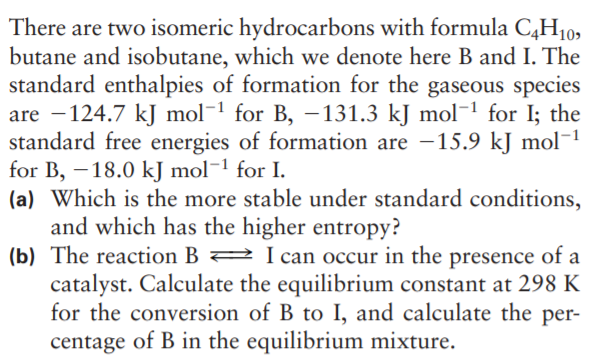There are two isomeric hydrocarbons with formula C,H10, butane and isobutane, which we denote here B and I. The standard enthalpies of formation for the gaseous species are -124.7 kJ mol¬1 for B, -131.3 kJ mol-1 for I; the standard free energies of formation are -15.9 kJ mol¬1 for B, -18.0 kJ mol¬1 for I. (a) Which is the more stable under standard conditions, and which has the higher entropy? (b) The reaction B 2 Ican occur in the presence of a catalyst. Calculate the equilibrium constant at 298 K for the conversion of B to I, and calculate the per- centage of B in the equilibrium mixture.
There are two isomeric hydrocarbons with formula C,H10, butane and isobutane, which we denote here B and I. The standard enthalpies of formation for the gaseous species are -124.7 kJ mol¬1 for B, -131.3 kJ mol-1 for I; the standard free energies of formation are -15.9 kJ mol¬1 for B, -18.0 kJ mol¬1 for I. (a) Which is the more stable under standard conditions, and which has the higher entropy? (b) The reaction B 2 Ican occur in the presence of a catalyst. Calculate the equilibrium constant at 298 K for the conversion of B to I, and calculate the per- centage of B in the equilibrium mixture.
Principles of Modern Chemistry
8th Edition
ISBN:9781305079113
Author:David W. Oxtoby, H. Pat Gillis, Laurie J. Butler
Publisher:David W. Oxtoby, H. Pat Gillis, Laurie J. Butler
Chapter13: Spontaneous Processes And Thermodynamic Equilibrium
Section: Chapter Questions
Problem 21P
Related questions
Question

Transcribed Image Text:There are two isomeric hydrocarbons with formula C,H10,
butane and isobutane, which we denote here B and I. The
standard enthalpies of formation for the gaseous species
are -124.7 kJ mol¬1 for B, -131.3 kJ mol-1 for I; the
standard free energies of formation are -15.9 kJ mol¬1
for B, -18.0 kJ mol¬1 for I.
(a) Which is the more stable under standard conditions,
and which has the higher entropy?
(b) The reaction B 2 Ican occur in the presence of a
catalyst. Calculate the equilibrium constant at 298 K
for the conversion of B to I, and calculate the per-
centage of B in the equilibrium mixture.
Expert Solution
This question has been solved!
Explore an expertly crafted, step-by-step solution for a thorough understanding of key concepts.
This is a popular solution!
Trending now
This is a popular solution!
Step by step
Solved in 3 steps with 13 images

Recommended textbooks for you

Principles of Modern Chemistry
Chemistry
ISBN:
9781305079113
Author:
David W. Oxtoby, H. Pat Gillis, Laurie J. Butler
Publisher:
Cengage Learning

Chemistry
Chemistry
ISBN:
9781305957404
Author:
Steven S. Zumdahl, Susan A. Zumdahl, Donald J. DeCoste
Publisher:
Cengage Learning


Principles of Modern Chemistry
Chemistry
ISBN:
9781305079113
Author:
David W. Oxtoby, H. Pat Gillis, Laurie J. Butler
Publisher:
Cengage Learning

Chemistry
Chemistry
ISBN:
9781305957404
Author:
Steven S. Zumdahl, Susan A. Zumdahl, Donald J. DeCoste
Publisher:
Cengage Learning


Chemistry: An Atoms First Approach
Chemistry
ISBN:
9781305079243
Author:
Steven S. Zumdahl, Susan A. Zumdahl
Publisher:
Cengage Learning

Chemistry: The Molecular Science
Chemistry
ISBN:
9781285199047
Author:
John W. Moore, Conrad L. Stanitski
Publisher:
Cengage Learning

Chemistry: Principles and Practice
Chemistry
ISBN:
9780534420123
Author:
Daniel L. Reger, Scott R. Goode, David W. Ball, Edward Mercer
Publisher:
Cengage Learning